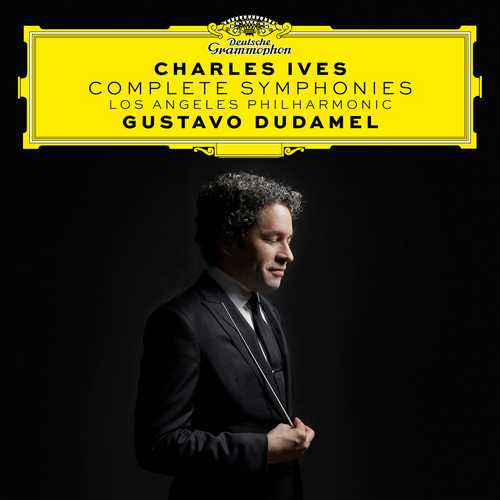
Composer: Charles Ives
Orchestra: Los Angeles Philharmonic
Conductor: Gustavo Dudamel, Marta Gardolińska
Audio CD
Number of Discs: 1
Format: FLAC (tracks)
Label: Deutsche Grammophon
Size: 2.37 GB
Recovery: +3%
Scan: cover
Symphony No. 1
01.I. Allegro con moto
02. II. Adagio molto. Sostenuto
03. III. Scherzo. Vivace
04. IV. Allegro molto
Symphony No. 2
05. I. Andante moderato
06. II. Allegro
07. III. Adagio cantabile
08. IV. Lento maestoso
09. V. Allegro molto vivace
Symphony No. 3 “The Camp Meeting”
10. I. Old Folks Gatherin’ – Andante maestoso
11. II. Children’s Day – Allegro moderato
12. III. Communion – Largo
Symphony No. 4
13. I. Prelude. Maestoso
14. II. Comedy. Allegretto
15. III. Fugue. Andante moderato
16. IV. Finale. Very slowly – Largo maestoso
Charles Ives – Complete Symphonies offers fresh insights into the music of a radical thinker, creator of what Leonard Bernstein called “his own private musical revolution.” The Los Angeles Philharmonic’s performances of these works at Walt Disney Concert Hall, conducted by Music & Artistic Director Gustavo Dudamel, received rave reviews.
With their restless energy, myriad colors and textures, irresistible references to popular American melodies and impulsive changes of mood, these symphonies reveal the heart of “a man full of ideas [who] was trying to create something unique,” according to Dudamel. “When you see calm and contemplation, maybe in a moment it’s complete chaos. At the end, what Ives was doing was opening the door to the texture and the personality of music created in the United States. His symphonies are a great gift to the world.”
Charles Ives was an American original, an artist ahead of his time who explored novel combinations of traditional classical forms and American vernacular music, pioneering and exploiting techniques of polytonality, polyrhythm and textural complexity. These recordings offer fresh insights into the music of a radical thinker, creator of what Leonard Bernstein called “his own private musical revolution.” Maestro Dudamel’s special affinity for the composer’s symphonies and the performance of the Los Angeles Philharmonic earned excellent reviews during the orchestra’s Ives-Dvořák festival earlier this year. “It was, in its every gesture, vibrantly, rapturously, outrageously American,” commented the Los Angeles Times on their performance of the First Symphony. Continuing about the Second Symphony the newspaper wrote: “[Their interpretation of Ives’s] Second exceeded even the American gold standard set by Leonard Bernstein, who premiered the symphony in 1951 and was, until the end of his life, its most insightful exponent.”
“Dudamel found the precise balance between old and new here by making every line, every piece of counterpoint, every buried flute melody or sudden string pizzicato attention-catching, a musical topography in which every detail has a story to tell.” (Los Angeles Times)
According to San Francisco Classical Voice, “The most significant takeaway from Gustavo Dudamel’s cycle of Charles Ives’s four symphonies with the Los Angeles Philharmonic is this: he is one helluva fine Ives conductor.” The reviewer praised the conductor for extracting “the essence of every aspect, quirk and vision of this American iconoclast.” Dudamel’s readings of the symphonies grow from his delight in their restless energy, myriad colors and textures, irresistible references to popular American melodies and impulsive changes of mood. “Ives was a man full of ideas and he was trying to create something unique,” the conductor comments. “When you see calm and contemplation, maybe in a moment it’s complete chaos. At the end, what Ives was doing was opening the door to the texture and the personality of music created in the United States. His symphonies are a great gift to the world. I’m delighted that we could record these amazing works for Deutsche Grammophon.”
Charles Ives – Complete Symphonies represents a significant new addition to the Deutsche Grammophon catalog. The Yellow Label’s album opens with the First Symphony, written between 1898 and 1908 but not performed complete until 1953. The five-movement Second Symphony (c.1907–09 with later revisions) underlines Ives’ maverick status with its ultra-progressive combination of European classical and American popular influences. Subtitled “The Camp Meeting,” the Third Symphony (1908–11) received the Pulitzer Prize for Music in 1947, noted for its nostalgic reflections on the hymns, marches and campfire tunes of the composer’s New England childhood. The Fourth Symphony (c.1912–18 with later revisions) received its premiere in 1965, more than a decade after Ives’ death, and remains a benchmark of musical invention, ingenuity and ambition.
About the Composer: Charles Ives was born in 1874 in Danbury, Connecticut. His father was the youngest bandmaster in the Union Army during the American Civil War and encouraged his son to make music. Young Ives also excelled at baseball and American football. He received a solid grounding in harmony and counterpoint from his composition professor at Yale University, and ran experiments in mixing different types of music with the Hyperion Theater Orchestra. Ives made his living in the insurance business and composed in his spare time, a practical arrangement that delivered great creative freedom. This staunchly independent thinker synthesized the American folk tunes and hymns of his childhood with his own aesthetic, using techniques such as bitonality and polyrhythms decades before they entered the standard 20th-century composition toolbox to create a unique sound and a personal voice – truly, an American original.



